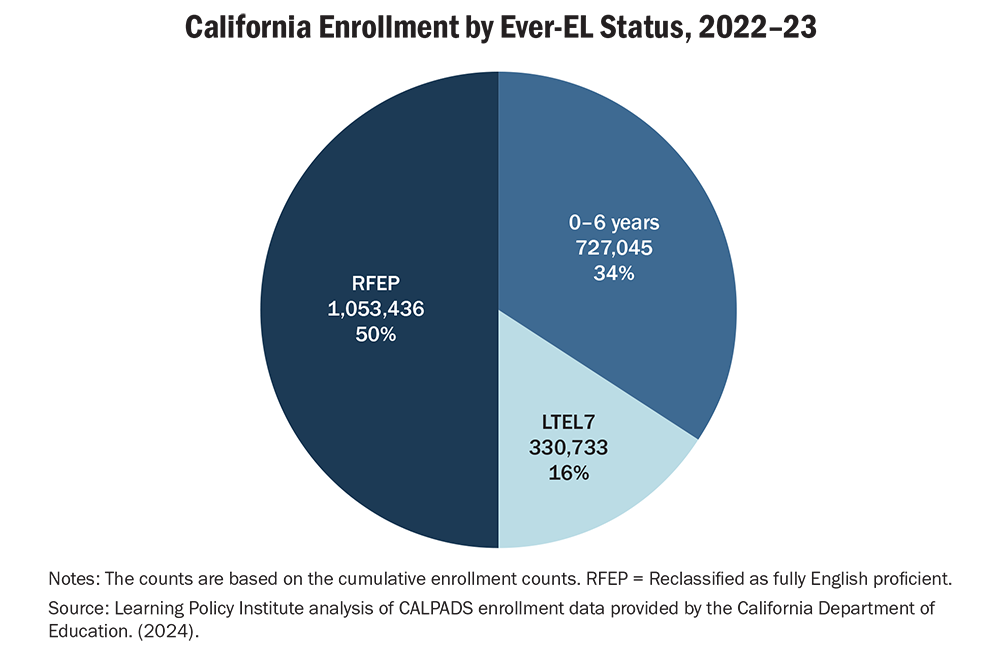Long-Term English Learners in California

What is California’s policy on Long-Term English Learners?
In the 2022–23 school year, about 40% of all California’s K–12 students come from homes in which a language other than English is spoken, and nearly 1 in 5 of the state's 5.8 million K–12 students were classified as English learners (ELs)—students whose first language is not English and who have not yet achieved fluency in English. These students receive specialized support to help them gain English proficiency. Research shows that with support, most ELs gain adequate English proficiency in 5 to 7 years and are then reclassified as fluent English proficient (RFEP). However, when students remain ELs for 6 or more years without making progress in the last 2 years, California classifies them as long-term English learners (LTELs).
To support this group of ELs, the California State Board of Education added a new LTEL category this school year to the California School Dashboard, the state’s tool for reporting the performance of schools and student groups. For reasons of timely data availability, the dashboard will designate LTELs as a group of students who have been classified as ELs for 7 or more years. This new category provides the data needed for school districts to plan programs and budget investments for LTELs as a distinct group in their annual Local Control and Accountability Plans, an additional requirement.
To understand how to support this population of students, the Learning Policy Institute conducted research into the characteristics, locations, school contexts, and academic performance of both LTELs (referred to as "students designated as LTEL7" in the related report) and students who have been reclassified or who are in their first 6 years classified as EL (referred to as “other ever-ELs”). The research was based on 2022–23 data.

What do we know about students designated as LTELs?
Key findings are highlighted below and are explained further in the full report.
Overall Characteristics
Compared to their other peers who were ever-ELs, students designated as LTEL7 were more likely to be:
- Special education students (28% vs. 11%)
- Socioeconomically disadvantaged (89% vs. 80%)
- Boys (56% vs. 51%)
In addition, students designated as LTEL7 were much more likely to enter school at the lowest level of English proficiency (64% vs. 40% scoring at a Beginner level on the initial English proficiency assessment).
Location and School Contexts
- Students designated as LTEL7 were primarily enrolled in schools in the most populous counties—Los Angeles, Orange, Riverside, San Diego, and San Bernardino. However, schools with students designated as LTEL7 representing the greatest share of their English learners were disproportionately in rural counties.
- Schools with higher concentrations of students designated as LTEL7 had:
- Higher concentrations of students from low-income families
- Fewer courses taught by fully certified staff
- Higher rates of chronic absenteeism
- Lower rates of high school graduation
- Lower likelihood of offering a Seal of Biliteracy, recognizing those proficient in at least two languages
Academic Outcomes
- Students designated as LTEL7 scored lower than their ever-EL peers on the state tests in English language arts (ELA) and math for grades 6–8 and grade 11. Additionally, some students designated as LTEL7 who reached the recommended academic achievement cut point on the California Assessment of Student Performance and Progress ELA test were not yet reclassified as RFEP.
- Compared to their other ever-ELs peers, students designated as LTEL7 were less likely to receive a high school diploma (69% vs. 86%), with the high school exit status of 20% of students designated as LTEL7 as "unknown."
What can be done to support these students?
- Ensure all students, including those designated as LTEL7, have access to adequate school resources and necessary whole child supports. Nearly 9 out of every 10 students designated as LTEL7 are classified as socioeconomically disadvantaged. Along with access to fewer resources in schools, these students may have less access to resources outside of school than their peers.
- Continue to address the statewide teacher shortage. Additional support for both recruitment and retention of qualified teachers may be needed in schools of concentrated poverty and in rural and remote areas, where students designated as LTEL7 are more likely to be enrolled.
- Focus on better identifying and addressing the needs of English learner students in their early years, especially given the high proportion of students designated as LTEL7 who are also eligible for special education services. This includes exploring how to better support students designated as LTEL7 with disabilities and determining appropriate testing accommodations for reclassification.
- Collect more data on how districts support English learners. A lack of data on what types of programming districts use for teaching ELs leaves questions about how to ascertain the most effective instructional approaches. A lack of data on district-specific criteria for reclassification as fluent English proficient leaves questions about the different targets students need to meet.
- Conduct further research on the experiences of students designated as LTEL7. This includes research on reclassification processes, academic opportunities, and supports needed for graduation.
Sobrato Philanthropies provided funding for this project.
